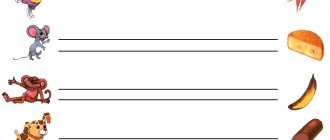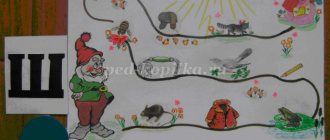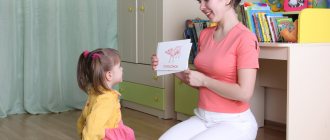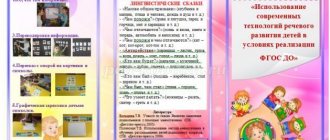Every person's speech consists of sounds. The child’s development depends on how correctly the letters are pronounced. If a child under 5–6 years old makes mistakes in reproducing phonemes, you should seek help from a specialist.
Recently, incorrect pronunciation of the letter D has become increasingly common among children. To eliminate the defect, the sounds “D” and “D” should be produced and automated.
Types of deviations
Characteristics of pronunciation defects:
Consonant voiced
Stun.
the sound “D” at different positions in words turns into
steam room
deaf
I agree
"T". The disorder occurs due to the similarity in the location of the articulatory apparatus during reproduction, poor development of phonemic perception and organic deficiencies of the speech organs. The defect is eliminated again using the phoneme “B”.- Open twang. Replacing the sound
“D” with “N”. The sky curtain is down. The tip of the tongue does not push away from the incisors. There is no push of the air stream from the oral cavity. The air leaves the nasal cavity in a continuous manner. - Clicking "D". Correction is carried out by regulating breathing during pronunciation.
You can check correct reproduction in the form of a small test, suitable for older
groups
of preschoolers
:
- An adult pronounces sentences with frequent letter repetition. For example, Dina blows a trumpet. The child is asked to repeat what he heard.
- Using illustrations of objects with the sounds “D” and “D”. Place the pictures
in front of the child. Ask to name what is depicted on them (oak, house, melon, children, hollow, etc.) - Search for the desired picture. The adult says the name of one depicted object among the presented pictures, and the child finds it and names it.
Such simple tasks are used in preparatory groups
to identify defects in sound pronunciation and to develop the thinking abilities of children. Similar activities are used for all types of phonemes.
Sonora
This group includes “L”, “R” and their soft pairs. It is advisable to begin the correction with them, simultaneously working on the preparatory stage for the hissing ones. Often they are quickly processed.
There are three ways to set sound:
- mechanical - it requires probes or their substitutes;
- by imitation - not always possible;
- mixed - implies the use of both.
Producing the sound “R” with dysarthria is better done with a probe. Due to problems with the motor muscles, it will not be possible to call him by imitation. The probe looks like a smooth stick with a small ball at the end.
It is better to place the child on his back. He should relax. He is asked to open his mouth, place the tip of his tongue on the alveoli and pronounce the distorted sound “Z” (provided that it is in speech). At this moment, the tongue is gently swung with a probe.
With fast movements, a proper roar will be heard. Focus the preschooler's attention on this moment. Unlike other sounds, automation can begin with mechanical assistance. To do this, it is better to use combinations of syllables with “TR” and “DR”.
Gradually, unnoticed by the child, the probe moves away, and the preschooler begins to growl correctly. After syllables, words are used and the last stage is tongue twisters and stories.
The “L” sound is best placed interdentally. To do this, the child is asked to lightly bite the tip of his tongue and pronounce the sound “Y”. This exercise is called the “steamboat whistle”.
After this stage can be reproduced well, you need to remove the tongue behind the teeth.
This requires a little trick. The preschooler is asked to imagine that the tongue is a mouse. To hide it, you need to quickly remove the tip after the beep. In this case, it will automatically strike the alveoli and the correct “L” sound will be heard.
Automation happens the same way. First, they use forward and backward syllables, then words, then tongue twisters.
In order to make this process interesting, different games are used. For example, to automate syllables, they suggest imagining that the room is a swamp. To move, you need to jump over bumps and pronounce syllables.
Or they use a variety of walking board games. The marbles are laid out in circles, passed through with your fingers, etc.
Causes of pronunciation problems
The occurrence of incorrect reproduction of soft and hard
"D" is accompanied by:
- lack of correct articulation
of the speech organs; - underdevelopment of phonemic hearing (the child does not distinguish sounds from each other);
- repeating the mistakes of others;
- weak motor activity of the lower jaw and other organs of the speech apparatus (occurs with dysarthria).
Don't miss: What is SSD (speech development delay)?
Note: dysarthria is a violation of the innervation of the speech organs. The deviation appears due to damage to the central nervous system.
It is possible to establish an accurate diagnosis and cause after speech therapy
examinations.
After collecting a detailed history, the speech therapist
prescribes corrective
tasks
. Some classes should be done at home.
Speech hearing
In order for a child to successfully learn a new pronunciation, he must distinguish it by ear. This is also important for differentiating different groups, for example, voiced and deaf.
Therefore, development begins with the use of non-speech material. For example, a child is shown how paper crumples, a pencil knocks on the table, water pours from glass to glass. Afterwards he is asked to turn away and he must determine the action by ear.
You should not give your preschooler the opportunity to guess! Any attempts to randomly give out an answer must be stopped. The speech therapist does not answer questions, but you can suggest the thought “what do you think is babbling?” or “what’s rustling?”
You can show pictures of musical instruments and show a sample of their sound. Afterwards, the passages are turned on in random order, and the child must show the correct answer.
Another simple task that can be easily done at home. The preschooler is asked to close his eyes and listen to the world around him. He must determine what is happening around him. For example, the car is driving, mom is washing dishes in the kitchen, the cat is meowing, etc.
Only after the discrimination of non-speech sounds begins to go well, do they move on to speech sounds. To begin with, use vowel sounds.
You cannot give an image of a letter - this will confuse the child and confuse him. The signs proposed by Tkachenko are used as symbols.
The preschooler is explained how to pronounce the sound “A” (with his mouth wide open) and shown a large red circle - it will be a symbol. Then the sounds “U” and “O” are analyzed. Tasks are offered to determine sound during silent articulation.
Little by little they learn to identify the place of sound. For example, they call the series “O, A, O” and ask them to say which sound is the first. To facilitate understanding, they show a picture of a train or car (telling that there is a beginning, middle and end).
Only after this stage has been perfectly mastered do they move on to producing the “C” sound in a child with dysarthria and others.
Correct articulation for the sounds D and D
When playing the sound “D” the speech apparatus takes the position:
The lips are completely neutral. The production depends on the subsequent vowel phoneme. The distance between the lips and incisors is about 5 mm.- The tip of the tongue rests on the upper jaw. May touch the alveoli behind the upper teeth.
- The soft part of the palate descends.
- The larynx vibrates.
- The vocal folds are closed. Presence of voiceover.
The articulation of the soft “D” differs from the hard one only in the position of the tongue. Its tip falls behind the lower incisors.
Important: Classes aimed at establishing phonemes should be conducted after the child has mastered simple vowels and consonants (a, y, o, i, e, s) and (b b, p p, mm, v v, f f).
Supporting measures
Often with dysarthria there is an increased or decreased tone of the speech organs. In order to cope with this problem, speech therapy massage is used.
It can be either manual or probe. The procedure consists of stroking and light pressure on different areas. This is often done at the beginning of each lesson. This makes the muscles susceptible to the effects.
Dysarthria is often accompanied by increased salivation. To reduce secretion, give jelly, chew biscuits and crackers. Before the lesson, the child is seated on a chair, asked to throw back his head and imitate chewing. The speech therapist can massage the points behind the ears and the junction of the jaws. This will reduce the work of the glands.
There are no uniform patterns when producing sounds. For each child, methods are selected individually.
Exercises for staging
Before you begin to master the phoneme, you should go through the preparatory stage. It consists of performing special articulation and breathing exercises (here). The child must be taught correct articulation (position of the speech organs) and breathing during the pronunciation of an isolated sound.
Articulation gymnastics
The classes are designed to train the organs involved in the pronunciation of the sounds “D” and “D” description
:
- Lower jaw. Open your mouth wide. Use your lower jaw to imitate chewing movements. Perform for 10-15 seconds.
- Lips and cheeks:
- lips are closed, and air should be drawn into the oral cavity. Next, imitate rinsing as after brushing your teeth in the morning;
- use your lips to make characteristic sounds for a horse (snorting);
- pouting lips in turn. First the top, then the bottom.
3. Language:
Exercise "Mushroom"
- "Fungus". Smile widely with your mouth open. The flat tongue is sucked to the palate. In this case, the organ should be located behind the upper incisors. Hold the position for 10-15 seconds.
- "Horse". Click your tongue on the hard palate, imitating the sound of a horse's hooves.
- "Swing". Open your mouth wide, slightly exposing your teeth. Place the tongue behind the upper and lower teeth in turn. Performed 5 times.
Don't miss: How to diagnose dyslalia?
4.Soft palate. The baby is asked to reproduce vowel sounds. The pronunciation is soft at first, and then a hard attack is applied.
Advice: to prevent your baby from getting bored with doing the same exercises, you can use classes prescribed for speech therapists. Many options are available on the Internet.
Breathing exercises
Experts suggest performing paradoxical gymnastics according to Strelnikova. But its use is allowed for children 7-8 years old ( grade 1
). Exercises should be performed under the supervision of parents or a specialist. Initial exercises:
- Palms. The child stands up straight. He bends his arms at the elbows and shows his palms to the adult. Hands clench into fists as you inhale and unclench as you exhale. You need to breathe through your nose. Perform the exercise 4 times.
- Shoulder straps. The baby is standing upright. Hands clenched into fists. They are pressed to the belt. While inhaling, hit the floor with your fists. Gradually unclenching your hands. As you exhale, return to the starting position. Do it 4 times.
- Pump. From a level stance, make a slight forward bend. The arms are hanging at the sides. Simulate tire inflation. Lean forward and inhale. As you exhale, return to the bent position.
Important: the technique has many contraindications, so you should consult a pediatrician before performing it.
To train children's breathing, use the “tube” exercise. The lips are pulled forward. Inhale through the nasal cavity, exhale a stream of air using a formed tube. Perform 4-5 times.
Techniques for producing sounds T D
The classic techniques of speech therapy work are the preparatory stage and sound production, which can also be actively used in home exercises. If you choose the right exercises, it will not be difficult for parents to cope with their child’s speech disorders.
Important: before teaching a child the correct articulation of the sound T ( D ), the adult must himself practice the position of the lips and tongue in front of the mirror: the lips take the position of the vowel that follows T (ta - ta - ta); the tongue is fixed in the upper teeth; the palate is raised. In addition, articulatory gymnastics must also be previously rehearsed by an adult.
Preparatory stage
Speech therapists insist that if the baby’s tongue is not strong enough to make sounds, it is necessary to first strengthen the muscles of the tongue and lips. Therefore, the preparatory stage necessarily includes articulation gymnastics. Speech therapy massage exercises will help prepare the speech apparatus for it::
- An adult, using a mirror, teaches the preschooler to take the correct position of the lips and tongue, showing the differences in pronunciation, for example, T (tip of the tongue) and K (tail of the tongue): “The cake is being eaten,” “Drops are dripping.”
- Making the T requires a sharp and strong exhalation. Therefore, it is necessary to develop the ability to exhale correctly. You can use the following exercises: “Soap bubbles”, “Balloon”, “Flying snowflakes (from a napkin or cotton balls)”.
- Then follows articulation gymnastics:
- “Wide smile” – connect your teeth, stretch your lips wide and hold this position for up to 7 seconds.
- “Tick-tock clock” - the tongue quickly moves left and right along the upper lip.
- “The tongue does not obey” - say five-five-five, tapping your upper lip on your tongue, gradually differentiating (distinguishing) the sounds P T.
- “Tongue - spatula” - relax the tongue, making it wide, place it on the relaxed lower lip.
Important: we must try to make it interesting for the child to complete rather monotonous preparatory tasks. To do this, it is necessary to introduce new articulatory gymnastics exercises, which can be borrowed from speech therapy practice, at each home lesson.
Staging sounds
How to install sound at home? Experts offer several ways to set sound; a parent can try all of them and choose the one that is more accessible and understandable to the baby.
- Setting T by imitation: an adult invites a preschool child to repeat first the syllables, and then the words; it is advisable to start with the syllable “ta”. For example: ta-ta-ta, ta-you-to-tu, you-you-you, you-ta-to-tu, to-to-to, to-tu-ta-you. Then the transition to words - pure words: ta-ta-ta, ta-ta-ta, such beauty; you-you-you, you-you-you, gave us flowers; tu-tu-tu, tu-tu-tu, we clean up; so-and-so, so-and-so, I put on my coat. A creative approach to speech activities will allow parents to independently compose similar phrases in sound, involving children in creativity.
- Interdental method: an adult shows the child the position of the tongue (the tongue is pressed between the lips, in this position you need to exhale strongly until you hear a sound, then place the tongue behind the teeth). You can teach how to control your exhalation by playing a “fence” for air by placing your palm in front of your mouth. Or arrange a game of “ball” (a cotton ball is driven into an improvised goal with a stream of air).
- Speech therapists use the method of setting T from the sound P. The child repeats pa-pa-pa, placing the wide tip of the tongue on the lower lip, then, smiling broadly, pronounces P , resulting in T.
- When setting D , the work is identical, only when exhaling the voice is added.
Automation of sounds T D
When the sounds T D are delivered (correct articulation has appeared) and the child learns to pronounce them, the next stage begins - automation (practice of the skill). It is important to achieve fluent pronunciation here. Since this is new for a preschooler, it means a lot of training is required. Speech therapists recommend introducing the practiced skill gradually: first through syllables, then words, then sentences. Articulation exercises, games based on poetry, stories, riddles will help well in this work, which will also maintain interest in the classes. At the same time, do not forget that every home lesson must begin with articulatory gymnastics.
Important: parents need to make every effort to ensure that the incorrect pronunciation of T D disappears from the child’s speech as quickly as possible. It should be taken into account that new material is introduced only after the previous one has been mastered.
What can an adult do to keep the child interested in activities and at the same time repeat monotonous actions over and over again? Gaming techniques will help, with the help of which syllables are practiced, for example: ta-ta-ta, yes-da-da, to-to, do-do-do, ta-you-to-tu, at-at-at, yes-dy-du, yt-yt-yt, ud-ud-ud. Plots can be very diverse:
- Let's teach the doll to brush its teeth, show it what articulation gymnastics is: “let's brush the teeth” (various movements of the tongue on the teeth from the outside and inside, up and down, left and right).
- Let's sing a song to the toys: “tra-ta-ta, tra-ta-ta, we are taking a cat with us”;
- Play the drum for the bear: tram-ta-ta-tam; on a dog pipe: doo-doo-doo.
- I start speaking, and you finish (the adult pronounces part of the word, which must end in a syllable with the sounds T D ): flowers, beauty, candy, mast, coat, bouquet; bicycles, sneakers, beards.
- Hello, little finger! (the thumb is put forward, and each finger in turn “greets it” with the syllables: ta, to, tu, you; yes, do, du, dy).
After the preschooler has automated sounds, the work becomes more complicated, the pronunciation of sounds is fixed in words.
Exercise “Collecting beads”
An effective exercise on automating the sound T with older preschoolers. An adult invites the preschooler to collect unusual beads, having previously agreed which syllable should follow which. For example, there may be such a sequence: that - that - you - that - that - that. Work with the sound d is carried out in a similar way. At first, you can rely on visual aids (colored beads, circles of colored paper, pencils). Subsequently, the visualization is removed, and the child acts from memory.
Exercise “Come up with words with the sounds T D”
Invite the child to repeat after the adult words with the sounds T D at the beginning, middle, and end of the word. For example, an adult starts with a more understandable syllable ta : ta kidneys, ta chka, ta reel; The baby continues: ta NK, ta Buret, ta Nets, ta Xi. Then he moves to another position T D : cat , cock , roll , leaf ; sala t , play t , collect t , bark t , help t . Or daughter , yes , day , gifts , soldier ( voice emphasis on the highlighted one). If at first it is difficult for a preschooler to continue his vocabulary, you can work with pictures. The work with the syllables you dy : you qua, hole , you , dy m; then to : then por, then mouth, then thick, kind , then chka, dochka ; tu du : tu chka, tu loop, ra du ga, du ga. It is better to prepare the vocabulary in advance. An even more interesting automation exercise will take place with a ball. The adult throws the ball to the child with his word, the child responds with his own.
Exercise “Sound t and sound d in a sentence”
Similar work is done with sentences; the preschooler repeats after the adult, emphasizing T D :
- Tanya and Tom are traveling on a tram.
- Trofim is riding in a taxi.
- The plane is flying.
- Aunt Tonya is planting flowers.
- Dima and Tolya are skating on the skating rink.
- Dasha and Denis shared the melon.
- Children go to kindergarten.
In order for a preschooler to be able to independently compose a sentence, plot pictures are used. It is necessary to ensure that all words of the sentence have a sound that is automated ( T D ).
Nursery rhymes, pure sayings for automating sounds etc.
To make it easy for parents to choose an artistic series for practicing the sounds of T D, you can use speech therapy selections or come up with pure sounding phrases together with your children. For example, the parent starts with syllables, and the child then rhymes the sentence:
- Ta-ta-ta, ta-ta-ta, (they saw a whale in the sea ) .
- Tu - tu - tu, tu - tu - tu, (let's pour some milk into it ).
- Yes - yes - yes, yes - yes - yes, (splashed all over with water ) .
- water in the glass ).
- Yes - yes - yes, yes - yes - yes, (don't go there ) .
- doo , (go there anyway ).
A lot of nursery rhymes can be found on children's websites or in children's books. Their main task is to automate the sound T ( D ), its correct pronunciation, for example:
Shadow, Shadow, Shadow, above the city there is a fence. The animals sat on the fence and boasted all day long. The fox boasted: I am beautiful to the whole world! The bunny boasted: Go, catch up!
Pull the canvases, the canvases are simple. Pull, Pull, Pull, Across, across.
We know, we know: Yes-Yes-Yes! Water is hiding in the tap! Come out, water! We came to wash up!
LaDushki, LaDushki, Let's bake pancakes. We'll put it on the window. Let's leave it to cool. Let's wait a little, Let's give pancakes to everyone.
Differentiation of sounds D T
An important stage in speech therapy work is the differentiation of sounds (distinguishing similar sounds, T D, D D, T T). This stage is carried out in parallel with automation and is necessary in order to compare sounds (soft and hard) and practice pronunciation. You can teach a preschooler new special techniques for distinguishing sounds: a hand is applied to the throat while sounding, the sound is determined ( D - voiced, voiced; T - deaf, without a voice). For differentiation, you can use already known techniques: syllables, words, sentences in exercises, games, sayings, nursery rhymes.
Differentiation of sounds T ТТ in the exercise “Compare sounds in guesses”
An adult asks the child to guess riddles, and then asks if the sound of T in all the riddles? The main thing is to make it possible to understand the difference in the pronunciation of the sounds T (hard) T (soft).
Round, not a month, yellow, not butter, Sweet, not sugar, with a tail, not a mouse ( you kwa).
He bows, bows, when he comes home he will stretch out ( then ).
A block froze over the water, and she dreams of fish for lunch. There are fins and too lazy to swim, the fish will be eaten by another ( seal laziness).
Exercise “Correct phrasing”
The goal is to teach how to pronounce and distinguish DY .
Grandfather Dodon played the pipe, Grandfather hit Danka with the pipe.
A woodpecker is chiseling a tree, Day after day crushes the bark.
Game "Come up with a proposal"
To establish and consolidate the pronunciation of T D , adults can teach children to come up with beautiful sentences while relying on verbal helpers. Then determine which words have hard T D and which have soft Т Дь:
Denis - telephone (Denis was given a telephone); Home is a cat (Our cat doesn’t walk, he’s at home); Tanya - melon (Tanya loves melon); Tyoma is a pipe (Tyoma learns to play the pipe); Dusya - pictures (Dusya loves to look at pictures);
Important: parents should understand that home exercises for correct pronunciation consist of developing the skill of pronouncing the sounds of their native language. This process is long, systematic, and requires patience and persistent training in automation and sound differentiation. A thoughtful selection of articulatory gymnastics, exercises, games, and verbal material will help to achieve good results in the development of competent, beautiful speech in preschool children.
Staging
It is carried out after the child has mastered the position of the speech organs when reproducing a phoneme. Typically, 2 methods of producing the sound “D” and “D” are used:
. The baby and the adult sit in front of the mirror. A parent or specialist demonstrates the correct pronunciation of the sound. The child is asked to repeat. To make it easier, vowel sounds are used. For hard “D” (da – do – du – dy), and for soft “D” (di – du – de).
Imitation- Mechanical method. The child pronounces the sound “B”. The tongue is between the lips at this time. The speech therapist uses a special spatula to press on the tip of the organ. Then he pushes it behind the upper incisors.
Don't miss: How to teach how to pronounce the sound T
Experts often offer these methods of setting as homework.
. In a familiar environment next to a loved one, the baby will master classes faster.
Important: when performing exercises, point out the distinctive characteristics of the phoneme “D” from “T”. A special feature of the sound “D” is the vibration of the vocal folds. In order for the baby to feel the difference, his hand is placed on the larynx of an adult, who pronounces the letters in turn.
Set the sound [C]
The articulation is as follows:
- lips are in a neutral position;
- teeth are brought closer by 1-2 mm;
- the tip of the tongue is lowered, touching the lower incisors; Initially, the back of the tongue is strongly curved, forming a bow with the incisors, then its front part quickly moves to the position of the “C” sound, forming a groove in the middle;
- the air stream should be strong and uneven.
The sound “C” is produced if the child clearly pronounces the sounds “S” and “T”. The baby is asked to quickly pronounce “TS”, as a result of which the desired sound appears.
There are 3 ways to make the sound “C”:
- Method of imitation using play techniques (“The locomotive, stopping, says - tss-ts-ts”, “The mouse is sleeping, don’t make noise - tss-ts-ts!”).
- Reception of reference sounds (in this case these are “T” and “S”).
- Acceptance of the features of articulatory structure. Invite the child to open his mouth, rest the tip of his tongue against the incisors of the lower row of teeth, lift the tongue and stretch it so that its front part is pressed against the palate. In this position, the back of the tongue should touch the upper incisors. Without turning on your voice, invite your baby to pronounce the sound “T”, lifting the tip of the tongue with the pressure of a stream of air from the front teeth of the lower row. The lips should be tense and in a smiling position. This exercise helps to remember the position of the organs of articulation when the sound “C” is pronounced.
Automation of pronunciation
After articulation is established, the skill is practiced. Defects should be eliminated as quickly as possible without overloading the child. Each subsequent material must be offered after complete assimilation of what has been covered.
Various game exercises with songs, nursery rhymes, and tongue twisters will help you practice sounds, which will make children’s learning more interesting:
- Sing a song to your mother or grandmother: “Ta-ta, the cat has a fluffy tail...”.
- Play the drum for toys: tram-tam.
- Continue the word: decision, weather, flowers, nest.
- The fingers greet each other (the thumb greets the little finger, middle finger, thumb, index finger, saying tu, you, du, dy).
- We count Dalmatians: “The Dalmatian growled, He counted the spots, One, two, three, four, five, You can’t count them on your back!”
After automation, exercises are performed to consolidate the pronunciation of T, D in words.
- “Come up with words with T, D.” Adults name the words prepared on the cards with Ta at the beginning: plate, dance. The child continues: Tanya, slippers. With a ball, the activity will be even more interesting. Color the letter T in the pictures with one bright color and D with another.
- “Sounds T, D in a sentence.” The guys repeat the words, emphasizing T, D in their voices: Tamara is going home. A sperm whale swims. The snow has melted on the skating rink. The beautiful maiden sits in prison, and the braid is on the street. We can't understand Dasha. After all, Dasha has porridge in her mouth.
- Nursery rhymes, pure talk. Adults pronounce the first half of a short phrase, and the children come up with a rhyme that repeats the first syllable: Tu - tu, (I’ll catch some fish for the cat). That one, (oh, what a beauty). Yes, yes, (the beard darkened). Doo-doo, (I still won’t go).





